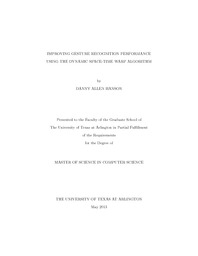
ATTENTION: The works hosted here are being migrated to a new repository that will consolidate resources, improve discoverability, and better show UTA's research impact on the global community. We will update authors as the migration progresses. Please see MavMatrix for more information.
Show simple item record
| dc.contributor.author | Hanson, Danny Allen | en_US |
| dc.date.accessioned | 2013-07-22T20:15:39Z | |
| dc.date.available | 2013-07-22T20:15:39Z | |
| dc.date.issued | 2013-07-22 | |
| dc.date.submitted | January 2013 | en_US |
| dc.identifier.other | DISS-12193 | en_US |
| dc.identifier.uri | http://hdl.handle.net/10106/11899 | |
| dc.description.abstract | The DSTW algorithm was originally used as the fundamental algorithm for a gesture recognition software. When the need arose for implementing gesture recognition on-board a robotic vehicle, the original recognition software needed to undergo several changes in order to meet the requirements of the target platform. The original software was written in Matlab and had to be ported into a native language in order to operate on the new platform. To support experiments needed to select a distance and τ function, the new code needed to be designed to support dynamic binding of distance and transition (τ) functions. The software needed to handle over 140 experiments to determine the appropriate distance and τ functions. A new classifier based on the A* algorithm was proposed and implemented to further reduce runtime performance, and a new τ function based on template matching between the various candidates provided by the detector was proposed and implemented. This work covers the results of theses efforts in Improving Gesture Recognition Performance using the Dynamic Space-Time Warp Algorithm. | en_US |
| dc.description.sponsorship | Athitsos, Vassilis | en_US |
| dc.language.iso | en | en_US |
| dc.publisher | Computer Science & Engineering | en_US |
| dc.title | Improving Gesture Recognition Performance Using The Dynamic Space-time Warp Algorithm | en_US |
| dc.type | M.S. | en_US |
| dc.contributor.committeeChair | Athitsos, Vassilis | en_US |
| dc.degree.department | Computer Science & Engineering | en_US |
| dc.degree.discipline | Computer Science & Engineering | en_US |
| dc.degree.grantor | University of Texas at Arlington | en_US |
| dc.degree.level | masters | en_US |
| dc.degree.name | M.S. | en_US |
Files in this item
- Name:
- Hanson_uta_2502M_12193.pdf
- Size:
- 1.146Mb
- Format:
- PDF
This item appears in the following Collection(s)
Show simple item record


